The terrorist movement of QAnon: its evolution from the Pizzagate to the assault on Capitol Hill
by Andrea Molle
January 6, 2021, will always be remembered as the day the US Congress was assaulted by a handful of Trump supporters incapable of admitting he lost the presidential election. It was supposed to be a dull session of Congress that should have just certified Joe Biden’s victory. Instead, Capitol Hill was invaded by dozens of protesters whose intention was to find and destroy the electoral college votes in a vain attempt to prevent the inevitable fall of Donald Trump. Despite his constitutional duties, the outgoing President failed to condemn them and the violence that would later cause four victims among the protesters. Instead, he asked them to leave and return home, expressed loved and admiration, and, most importantly, took once again the opportunity to repeat his unfounded claims of voting fraud. In what many analysts already see as the most dangerous constitutional crisis since the Civil War, among the protesters stood the followers of QAnon led by Jake Angeli, the “QAnon Shaman,” a legendary figure of the movement well-known to the authorities and all scholars of conspiracy theories.
What is QAnon, and why does it represent a danger to democracy?
The QAnon brand gathers the followers of the “conspiratorial revelations” of an anonymous internet user: a collective pseudonym named Q. QAnon is an American movement that, thanks to the COVID pandemic -19, has spread in over 70 countries and presents an extremely high risk of radicalization. The origin of QAnon is relatively recent, although conspiracy theories are typical of American society, at least since the Cold War. The need to carefully monitor this movement stems from the fact that its content and recent activities, including the Washington DC events, suggest that QAnon poses an extreme radicalization and public order issue.
When and how was QAnon born?
The origin of QAnon is relatively recent, although the layer of conspiracy theories from which it develops has been a constant in American politics since the Cold War. Officially, QAnon was born between 2016 and 2017 following the American presidential elections, which saw the Republican candidate Donald J. Trump, already identified as a messianic figure by the various conspiracy groups, prevail over the Democratic candidate Hillary Clinton. With Trump’s election, the groups that had supported his electoral campaign have formed his electoral base, which is independent and often in opposition to the traditional base of the Republican Party, and which Trump has continuously referred to for its political battles. Often censored by the mainstream media, these movements ended up gathering under the label of QAnon. Thus, creating the critical mass necessary to structure a whole network equipped with a parallel social media system, such as the well-known platforms 4chan, 8chan, gab .com, Parlor, and Telegram, to spread their theories and recruit new members. Thus, the QAnon brand has become a sort of franchise that gathers all those individuals and groups who refer to Q’s revelations. However, the movement does not have a fully hierarchical organization.
Who is Q, and what do QAnon followers believe?
In the beginning, Q introduced himself as a government official, willingly revealing the truth about the alleged “deep state.” His clues, whose interpretation is left to readers, depict the existence of a cabal made up of politicians, entrepreneurs, and actors dedicated to kidnappings, human sacrifices, and satanic cults, to achieve immortality and enslave the masses after the great reset caused by the pandemic. Given that the deep state was fought only by Trump, aided by few allied sovereign leaders, his defeat is now viewed by Q’s followers as proof of the conspiracy’s very existence. For this reason, the followers of QAnon are now active supporters of the theory of electoral fraud and, as we have seen, do not hesitate to engage in violent retaliation.

How is QAnon content built?
In addition to the aforementioned core belief of QAnon, each user or “truth search group” can add or modify content and adapt the message to their needs, as shown in the following model.
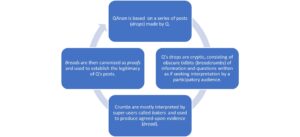
Based on the empirical evidence collected in the last two years, the scientific community that studies conspiracy theories and participatory culture see QAnon in continuity with the New Age phenomenon. QAnon is considered by scholars to be a novelty in the conspiratorial world and is frequently described as a real do-it-yourself, conspiratorial, open-world. The same analysts consider the risk of mass radicalization to be very high, especially among the population’s young and less educated strata. The interactive and very satisfying nature of its conspiratorial contents and the constant references to fictional-political literature make the QAnon experience extremely compelling.
How does QAnon spread, and how does it work?
Although it was born as a marginal phenomenon, QAnon quickly took hold of social media thanks to its contents flexibility. For example, on YouTube, conservative content creators such as TRU Reporting or SGT Report channel started producing dozens of videos inspired by Q’s clues, instantly garnering hundreds of thousands of views. A few months after Q’s debut, the movement already counted on a vast network of YouTube channels, podcasts, and books devoted to fighting the “deep state.” In addition to that, the inevitable themed gadgets such as flags t-shirts ended up becoming fashionable even among those not affiliated. QAnon slogans and symbols, such as the hashtag # WWG1WGA (“Where We Go One We Go All”), also begun to populate the ecosystem of social media and conservative movements. They also appeared in daily life and demonstrations supporting President Trump, who generally opposed the liberal political world. Simultaneously, the QAnon phenomenon began to manifest its most extreme and radical side, taking advantage of some of its followers’ self-radicalization. As early as 2017, with the famous Pizza Gate, which saw a gunman raid the Comet Ping Pong Pizzeria in Washington, DC, claiming to be on a mission to free the children held hostage in the basement, several QAnon affiliates have been implicated in facts of crime. It is estimated that in May 2020, as many as eleven murders, two armed assaults, two kidnapping cases, and two arson attacks against a family planning center, which offers pregnancy interruptions, and a mosque are attributable to members of QAnon. The growing number of cases has resulted in the designation of QAnon as an extremist organization and a potential internal terrorist threat by the FBI. It is the first conspiracy theory to be classified as such. However, the lack of a defined and structured organization with identifiable leaders made it very difficult for the American authorities to prosecute QAnon affiliates.
In many cases, these individuals adhere to its message and exploit the ideology but operate independently. For example, in this case of the Nashville attack, the attacker was motivated by an opposition to 5G technology and the SARS-COV-2 vaccine, which he considered government tools for controlling the masses. In others, the movement is presented in a more structured way, as showed by the assault at Capitol Hill.
How widespread is QAnon?
Speaking of its diffusion, QAnon is present in more than 70 countries with activities ranging from the individuals directly affiliated to occasional reposters of content. The spread of QAnon was undoubtedly helped by the recent COVID-19 pandemic and the constant decrease in institutions’ trust. Whereas goggletrend suggests fluctuating interest, the number of Tweets related to QAnon has increased from 5 million in 2017 to over 12 million in 2020. As for the number of followers, QAnon has now exceeded 1.5 million in the US while estimating around 500,000 affiliates in Europe.
Donald Trump is a critical figure in the conspiracy narrative, and QAnon remains mostly focused on American politics. However, we recently see a boom in Europe where the movement has followers on various social media. NewsGuard, an international organization that assesses news sites’ reliability, recently released an extremely detailed report on QAnon in Europe. In France, a country where the movement has been present for some time, albeit still to a limited extent, QAnon debuted thanks to the “Yellow Vests” movement and is ever since growing thanks to the No-Vax movement. In the UK, QAnon garnered support during the Brexit campaign. Without referring directly to the movement, groups such as Citizens Unite UK #wakeup use QAnon’s ideas, for example, the existence of a global elite, to push British citizens to fight the alleged government’s attacks on their rights. In Germany, the second-largest nation after the United States for QAnon’s presence, the movement entered the political debate through far-right movements and the generalized anti-Merkel sentiment that grew exponentially during the lockdown. Also, several leftist movements, particularly those linked to the climate change narrative, are increasingly attracted to his rhetoric. The number of german accounts associated with QAnon has risen to more than 200,000 according to the most recent estimate by the Amadeu-Antonio Foundation, which monitors right-wing extremism and anti-Semitism in Germany. The largest German-language QAnon channel on Telegram, Qlobal Change, quadrupled its followers in 2020 to an impressive 123,000 scoring over 18 million views for its YouTube content. In the Netherlands, social media accounts openly allied with far-right political movements have similarly borrowed themes typical to QAnon. It mostly happened when the country entered in lockdown because of the COVID-19 pandemic. In Italy, the real size of QAnon is still mostly unknown. However, Q’s propaganda has entered the political debate thanks to the populist and sovranist right that accesses it through various identity movements that openly support it.
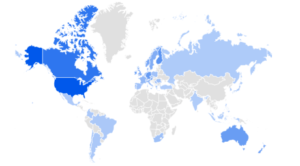
Who joins QAnon, and how to counter it?
As we have seen, QAnon raises severe concerns among analysts because of the speed, ease, and pervasiveness with which it spreads. Furthermore, it has already shown the potential for terrorist violence in America. It is therefore advisable to start monitoring QAnon’s presence on social media in Italy and establish a network of collaborations with public and private institutions that already deal with this phenomenon in Europe and the United States. It is also worrisome that mainstream sovranist movements increasingly amplify the conspiratorial message to mobilize votes without mentioning QAnon. Therefore, it is necessary to analyze the rhetoric and conspiracy themes to reach a level of understanding that makes it possible to detect them in contexts not directly related to QAnon.
We also need to understand the recruitment pathways and radicalization mechanisms. While it seems increasingly likely that the radicalization mechanisms are very similar to those of religious extremist movements, i.e., widespread self-radicalization and the presence of radicalism entrepreneurs, the target is still not entirely clear. The recruitment profile is still unclear where all the population strata are susceptible to a fascination for QAnon. The only exception is political affiliation, which may partly explain the impact of Q’s theories. A recent survey by Morning Consult, conducted between 6 and 8 October 2020 on a sample of 1,000 adults, reveals that around 24% of adult Americans believe the claims made by Q’s supporters are very or partly accurate. However, the same poll shows profound differences between Democrats and Republicans. While only 18% of Democratic voters believe some of the claims are somehow accurate, about 38% of Republican supporters consider them valid. Another survey by Daily Kos / Civiqs, which reports the interviews conducted on approximately 1,368 adults conducted from August 29 to September 1, 2020, confirms the previous findings. The results show that about one in three Republicans (33%) believe QAnon’s theory of a conspiracy about the “deep state” is “mostly true,” while another 23% say that only “some parts” of it are correct.
On the other hand, only 4% of Democrats think that the theory is even partially true, while for 72% of Democrats, it is not true at all. The explanation for the differences is likely because Republican politicians have only sporadically disavowed the claims made by QAnon supporters, potentially because they rely on them for political support. In addition to blind support for Trump, one of the most striking examples is the recent election to Congress of Marjorie Taylor Green, who directly promoted and approved QAnon’s content in interviews and on its social media channels. In Europe, several right-wing sovranist parties have adopted QAnon’s rhetoric ever since the election of Donald Trump and the establishment in Rome of Bannon’s Study Center. Several scholars consider the former advisor to President Donald Trump to be the main responsible for the normalization of conspiracy theories. However, it is still challenging to determine the direction of the correlation effect, namely whether QAnon more easily influences those who manifest right-wing political tendencies or whether the movement’s followers, regardless of their initial political positions, become more inclined to move their vote towards right-wing parties over time.
In the future, the movement will likely require the same approach used today for extreme religious movements. Unfortunately, the lack of a defined organizational structure and the potential for mass radicalization still makes it extremely difficult to offer guidelines and specific policy recommendations.








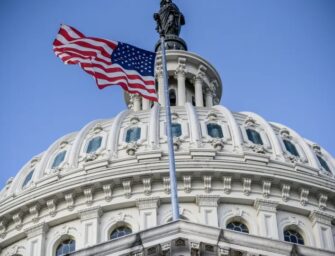

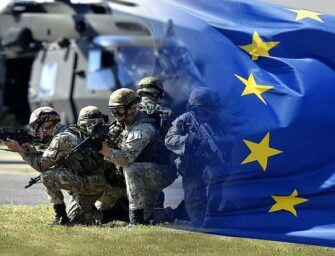



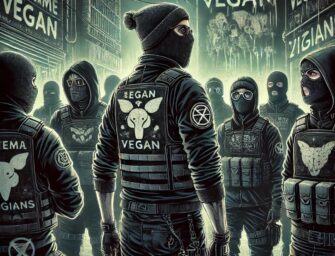





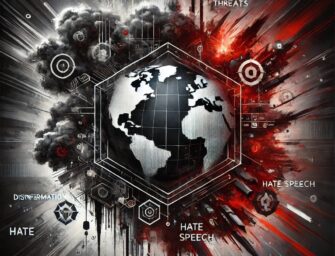


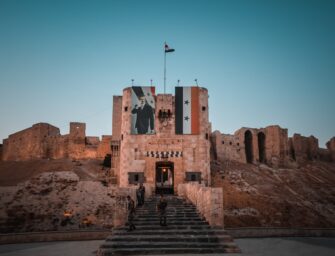










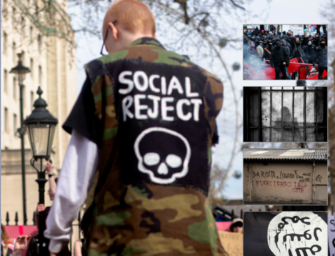
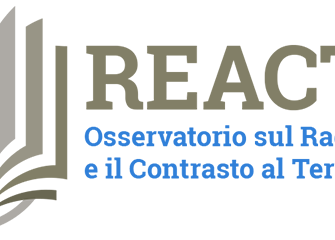
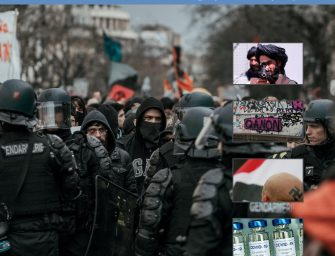





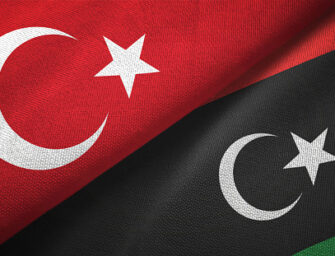
There are no comments
Add yours